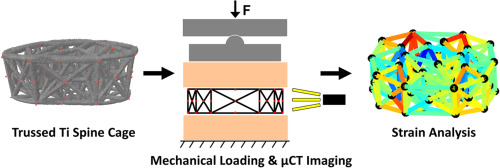Journal of the Mechanical Behavior of Biomedical Materials ( IF 3.9 ) Pub Date : 2018-02-03 , DOI: 10.1016/j.jmbbm.2018.02.004 Jason P. Caffrey , Eloy Alonso , Koichi Masuda , Jessee P. Hunt , Cameron N. Carmody , Timothy M. Ganey , Robert L. Sah

|
Titanium cages with 3-D printed trussed open-space architectures may provide an opportunity to deliver targeted mechanical behavior in spine interbody fusion devices. The ability to control mechanical strain, at levels known to stimulate an osteogenic response, to the fusion site could lead to development of optimized therapeutic implants that improve clinical outcomes. In this study, cages of varying design (1.00 mm or 0.75 mm diameter struts) were mechanically characterized and compared for multiple compressive load magnitudes in order to determine what impact certain design variables had on localized strain. Each cage was instrumented with small fiducial sphere markers (88 total) at each strut vertex of the truss structure, which comprised of 260 individual struts. Cages were subjected to a 50 N control, 1000 N, or 2000 N compressive load between contoured loading platens in a simulated vertebral fusion condition, during which the cages were imaged using high-resolution micro-CT. The cage was analyzed as a mechanical truss structure, with each strut defined as the connection of two vertex fiducials. The deformation and strain of each strut was determined from 50 N control to 1000 N or 2000 N load by tracking the change in distance between each fiducial marker. As in a truss system, the number of struts in tension (positive strain) and compression (negative strain) were roughly equal, with increased loads resulting in a widened distribution (SD) compared with that at 50 N tare load indicating increased strain magnitudes. Strain distribution increased from 1000 N (+156 ± 415 με) to 2000 N (+180 ± 605 με) in 1.00 mm cages, which was similar to 0.75 mm cages (+132 ± 622 με) at 1000 N load. Strain amplitudes increased 42%, from 346με at 1000 N to 492με at 2000 N, for 1.00 mm cages. At 1000 N, strain amplitude in 0.75 mm cages (481με) was higher by 39% than that in 1.00 mm cages. These amplitudes corresponded to the mechanobiological range of bone homeostasis+formation, with 63 ± 2% (p < .05 vs other groups), 72 ± 3%, and 73 ± 1% of struts within that range for 1.00 mm at 1000 N, 1.00 mm at 2000 N, and 0.75 mm at 1000 N, respectively. The effective compressive modulus for both cage designs was also dependent on strut diameter, with modulus decreasing from 12.1 ± 2.3 GPa (1.25 mm) to 9.2 ± 7.5 GPa (1.00 mm) and 3.8 ± 0.6 GPa (0.75 mm). This study extended past micro-scale mechanical characterization of trussed cages to compare the effects of design on cage mechanical behavior at moderate (1000 N) and strenuous (2000 N) load levels. The findings suggest that future cage designs may be modulated to target desired mechanical strain regimes at physiological loads.
中文翻译:

桁架式椎体间融合植入物中的应变受载荷和设计的调节
具有3D打印的桁架式开放空间架构的钛制笼子可以为脊柱椎间融合器中的定向机械行为提供机会。在已知的刺激骨形成反应的水平上控制机械应变对融合部位的能力可能会导致优化治疗植入物的开发,从而改善临床效果。在这项研究中,对不同设计的保持架(直径为1.00 mm或0.75 mm的支杆)进行了机械表征,并比较了多个压缩载荷大小,以确定某些设计变量对局部应变产生了什么影响。每个笼子在桁架结构的每个支柱顶点处都装有小的基准球标记(总共88个),该标记由260个单独的支柱组成。笼子受到50 N,1000 N,在模拟的椎骨融合情况下,轮廓加载板之间的最大压缩载荷为2000 N或2000 N,在此期间,使用高分辨率micro-CT对笼子进行成像。将笼子分析为机械桁架结构,每个撑杆定义为两个顶点基准点的连接。通过跟踪每个基准标记之间的距离变化,可以确定从50 N控制到1000 N或2000 N负载的每个支杆的变形和应变。与在桁架系统中一样,受拉(正应变)和受压(负应变)的支杆数量大致相等,与50 N皮重载荷相比,增加的载荷导致更宽的分布(SD),表明应变幅度增加。在1.00毫米笼中,应变分布从1000 N(+156±415με)增加到2000 N(+180±605με),与0相似。75毫米笼(+132±622με)在1000 N负载下。对于1.00 mm笼子,应变幅度从1000 N时的346με到2000 N时的492με增加了42%。在1000 N的笼子中,应变振幅在0.75 mm笼子(481με)中比在1.00 mm笼子中高39%。这些幅度对应于骨稳态+形成的力学生物学范围,在1000 N,1.00 mm时,该范围内的支撑杆为63±2%(与其他组相比,p <.05),72±3%和73±1%,在2000 N下为1.00 mm,在1000 N下为0.75 mm。两种保持架设计的有效压缩模量也取决于支杆直径,模量从12.1±2.3 GPa(1.25 mm)降至9.2±7.5 GPa(1.00 mm)和3.8±0.6 GPa(0.75 mm)。这项研究扩展了桁架保持架的微观尺度机械特性,以比较设计对中等(1000 N)和剧烈(2000 N)载荷水平下保持架机械性能的影响。这些发现表明,未来的笼子设计可能会被调整为在生理负荷下以所需的机械应变方案为目标。


























 京公网安备 11010802027423号
京公网安备 11010802027423号